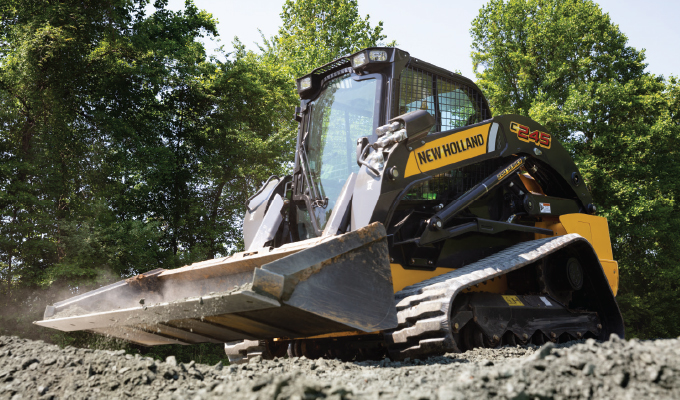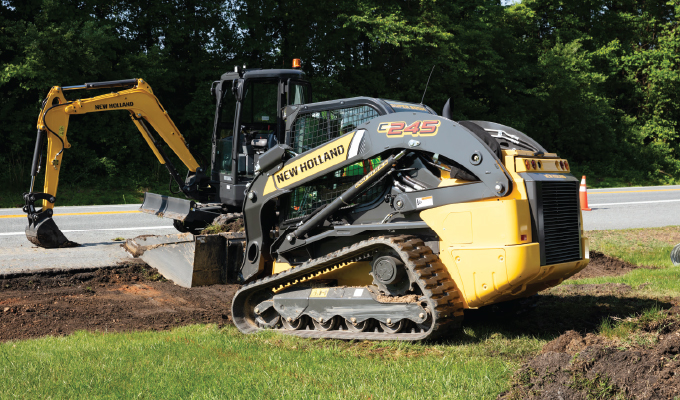By Ryan Anderson
For years, skid steer loaders (SSL) dominated the loader market for operations on the farm and the jobsite. The SSL has been one of the first machines to get started in the morning, and one of the last to be put away at night. Over the years, there have been several fundamental innovations driving the industry forward. The New Holland L35, for example, pioneered the use of a longer wheel base to give operators a more balanced and steadier loader.
In 1986, another general-purpose loader product was introduced: The Compact Track Loader (CTL) truly changed the game. Initially, the CTL wasn’t well adopted by the SSL operators in North America. Tracks didn’t last as long as tires, undercarriages and idlers didn’t have a solid, robust design yet, and some SSL owners just didn’t want to adopt a new loader type. As CTL’s evolved, the benefits of the CTL over the SSL became apparent. Eventually, operators started to see the advantages of tracks over wheels and the CTL started to gain a following among landscapers, general contractors, and even farmers.
LOADER OF CHOICE
Today, the CTL has become the loader of choice for landscapers, general contractors, and rental businesses. These types of applications need a machine that can go anywhere without losing traction and without disturbing the operating surface like an SSL. Since the CTL offers more surface area contact with the ground, they naturally achieve greater traction, offer easier lug cleanout, and create less ground pressure per square inch. This is particularly beneficial to landscapers who are doing jobs that require minimal damage to a turf surface.
Perhaps more importantly, CTLs deliver more efficiency and profitability for their operators. Since CTLs offer more surface area contact to the ground, they are able to achieve more effective tractive effort. This makes pushing and pulling loads easier. Contractors see the traction and ground pressure benefits when setting a grade on jobsite with significantly less corrective work. In addition, CTLs can go into environments where wheeled machines are just not viable. A good example of this is in forestry and land management applications where operators use mulching heads to clear land of trees and brush.
Of course, for a long time there were valid concerns about the longevity of tracks versus tires. For operators that mainly run in hard surface environments like concrete, there was also the obvious benefit of a more comfortable ride. However, track and undercarriage design have come a long way.
LONGER LIFE TRACKS
Today, track manufactures are coming out with longer life tracks through advances in track design and rubber composition. Now it is not uncommon to see a set of tracks last between 600 and 2,000 hours. Equipment manufacturers also noticed the market trends and started designing more robust track designs with improved idlers, and even suspension. Equipment manufacturers have a variety of suspended track designs to allow operators to work with more comfort in the cab during those long work days. As the track technology and undercarriage designs continue to evolve, more and more operators are converting from SSLs to CTLs.
MACHINE BALANCE
Not only are there traction and track lifespan advantages to CTLs, but overall machine balance is something to be considered. The kinematics of the SSL and CTL are dependent on the center of gravity of the machine. How a machine’s weight is distributed directly affects the lifting capabilities and overall performance of the machine. Being able to effectively lift and carry materials is a basic requirement for light construction loaders. By design, CTL’s have more weight on the machine from added componentry in the track undercarriage. This helps significantly when lifting heavy loads and allows a CTL to be a more balanced and effective lifting machine when compared to an SSL.
The CTL industry in North America is growing. In particular, the 4,000-pound rated operating capacity (ROC) at 50-percent tipping load is the segment driving that industry growth. This is why more manufacturers are placing an emphasis on the larger CTL products.

CTL MARKET GROWS
Ultimately, the compact track loader market continues to grow in popularity. Manufacturers are coming out with large and more powerful compact track loaders. More operators are seeing the benefits of tracked machines over wheeled. Of course, there will always be a place, in the market and on the jobsite, for the skid steer loader. From concrete and road applications to snow removal, there are still applications where a wheeled machine is ideal, but there are very few places a tracked machine can’t go. As the design and technology of the CTL continues to evolve, so does its versatility. As landscapers, general contractors, and rental houses are getting more demand for a wider variety of tasks, the CTL will almost always answer the call.
About the author
Based in New Holland, Pennsylvania, Ryan Anderson is the skid steer loader and compact track loader product marketing specialist for New Holland Construction. New Holland Skid Steer Loader and Compact Track loaders are manufactured in the U.S.A. out of Wichita, Kansas.
Modern Contractor Solutions, June 2019
Did you enjoy this article?
Subscribe to the FREE Digital Edition of Modern Contractor Solutions magazine.



